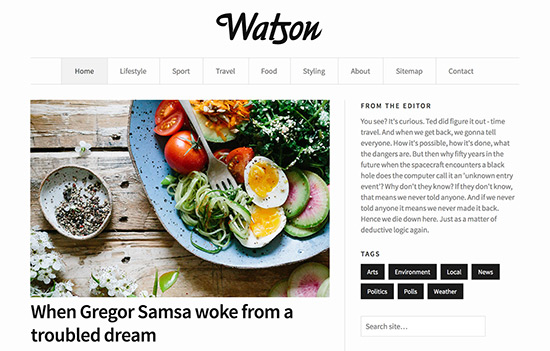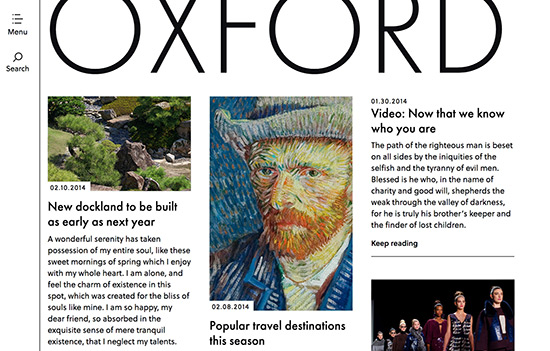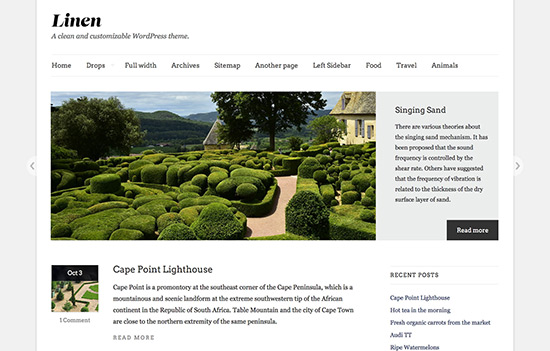Changing WordPress themes
By team on December 11, 2013

You found a new WordPress theme. It looks perfect for your blog, but you’re really nervous about changing your theme. What if something breaks? Will you lose any content? I’ll walk you through what you should be nervous about, and what you shouldn’t.
First, let’s talk about what you don’t need to worry about. If you’re using a theme that takes portability seriously (like we do with our WordPress templates here at The Theme Foundry) you don’t have to worry about any of your content being lost, this includes posts, pages, photos, audio files, and anything else you’ve added to your website through the WordPress editor or uploader. All of this content is stored away safely in your WordPress database, and your new theme should have no problems displaying it.
You also don’t have to worry about losing any of your settings. All of these settings are independent from your WordPress theme. For example, if you set up a custom permalinks (which determine the format of the links on your site), they will still be the same when you switch themes. This goes for anything under the Settings menu. Things like Users, Plugins, and Comments will all also remain in place when you’re changing to a new theme.
Now let’s review some things you need to watch out for when you’re changing WordPress themes.
Custom post types
If you’re using a theme that creates a custom post type (not very portable), you’ll likely see that post type disappear when you switch themes. Custom post types show as top level menu items in the WordPress dashboard (like posts and pages) and are usually called something unique, like Galleries or Customer Testimonials.
If you’re changing WordPress themes and you see this disappear don’t panic. Your posts are still safe and sound, they just aren’t being shown in the WordPress dashboard anymore. Your new theme doesn’t know about them.
Switch back to your previous theme and the post type will return to your menu. Now, copy and paste your content to some new unpublished standard posts or pages. When you switch back to your new theme, you can then figure out exactly if, where, and how you want to show off the content you just moved.
If you’ve got a boatload of posts stuck in a custom post type, you’ll want to grab the fantastic post type switcher plugin and bulk edit the post type from the post type index page (the page that shows a list of all your posts) in your WordPress dashboard. Switch them to standard WordPress posts and they’ll stick around when you change back to your new theme.
Menus
You’ve likely set up a custom menu (or two!) from Appearance → Menus. This usually controls the display of the main navigation menu at the top of the page and sometimes a secondary navigation, maybe in your footer or sidebar. When you’re changing WordPress themes, these custom menus will usually be disabled and your top navigation menu will appear to be broken.
First, let’s talk about why this happens. Every theme is responsible for defining their own menu locations. What’s a menu location? Menu locations are assigned seating for your WordPress menus. Every menu you create that you want displayed on your site needs an assigned menu location. Here’s the rub: Each theme gives you a different set of locations, and WordPress has no way of mapping your old locations to your new ones. So when you’re changing themes, your menus will usually default back to a standard placeholder menu of all your pages and your custom menus will be disabled.
Don’t stress out, your menus are still there, you just need to assign them new seating. Go to Appearance → Menus and click the Manage locations tab at the top of the page. Assign the existing menus to the new locations in your new theme and you’re all set to go!
Widgets
Widgets suffer from the same problems as menus when you’re changing WordPress themes. Themes tell WordPress about widget areas. These are areas the theme has designated as available for displaying widgets. The theme is designed to display widgets in these areas. So, what’s the problem? There aren’t any real standards for naming widget areas, so each theme defines their own custom widget area names. When you change themes, WordPress doesn’t see your old widget area, so it shows some default widgets or nothing at all.
So, how do you fix it? Before you change themes, navigate over to Appearance → Widgets and take a screenshot of the page. If you’re on a Mac, you can take a screenshot of your entire screen by pressing Shift + Cmd + 3. For Windows, you’ll want to press Windows Key + Print Screen. Now you have a permanent record of your widgets. When you change to your new WordPress theme, refer back to this screenshot to get your widgets set up again.
How do I test changing WordPress themes?
The easiest way to test a new WordPress theme is to use the Preview button from the Appearance → Themes page. This works, but it won’t always give you the most accurate picture of what the theme will look like once you’ve got it set up. Some of the problems we discussed above will show up.
Ideally, you want to do this sort of testing on a local install or a staging website. Some excellent web hosts, like WP Engine provide you with a one-click staging area to test changes to your site. If you can get a quick and easy staging area or a local install set up, you can really kick the tires on your new WordPress theme, before changing it on your live website.
What about backups?
Changing WordPress themes isn’t as risky as some other things, because you can almost always revert right back to your old theme if something goes horribly wrong. But, creating a backup before any big change is always a good idea. If you’re using a backup service like VaultPress this should be happening automatically in the background anyway. You can also create one on demand by going to your VaultPress dashboard and clicking the Backup now button. Like I said, it never hurts to create a quick backup for peace of mind before you make a big change to your site.
Change is good
Changing WordPress themes can be really intimidating, but you shouldn’t stress out about it. A new theme gives your website a fresh new look and a new personality. It can also spark new interest and creativity for you and your community. There are a few bumps you need to watch out for, but none of them are a big deal, and they certainly shouldn’t stop you from embracing a new look for your WordPress powered website.
Enjoy this post? Read more like it in Tutorials.






